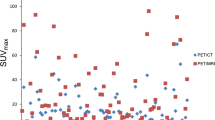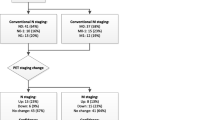Abstract
Purpose
To assess whole-body magnetic resonance imaging (wb-MRI) for detection of biochemical recurrence in comparison to 68Ga-prostate-specific membrane antigen positron emission tomography/computed tomography (68Ga-PSMA PET/CT) in prostate cancer (Pca) patients after radical prostatectomy.
Methods
This was a prospective trial including 28 consecutive patients (mean age 65.3 ± 9.0 years) with newly documented biochemical recurrence of Pca (mean prostate-specific antigen, PSA, 2.09 ± 1.95 ng/ml) following radical prostatectomy. All patients underwent both wb-MRI including a dedicated pelvic imaging protocol and PET/CT with 166 ± 35 MBq 68Ga-PSMA within a time window of 11 ± 10 days. PET/CT and MRI datasets were separately evaluated regarding Pca lesion count, type, localization and diagnostic confidence (three-point Likert scale, 1–3) by two nuclear medicine specialists and two radiologists, respectively. The reference standard was based on histopathological results, PSA levels following targeted salvage irradiation and follow-up imaging. Lesion-based and patient-based detection rates were compared using the chi-squared test. Differences in diagnostic confidence were assessed using the Welch test.
Results
A total of 56 Pca lesions were detected in 20 of the 28 patients. 68Ga-PSMA PET/CT detected 56 of 56 lesions (100%) in 20 patients (71.4%), while wb-MRI detected 13 lesions (23.2%) in 11 patients (39.3%). The higher detection rate with 68Ga-PSMA PET/CT was statistically significant on both a per-lesion basis (p < 0.001) and a per-patient basis (p = 0.0167). In 8 patients (28.6%) no relapse was detectable by either modality. All lesions detected by wb-MRI were also detected by 68Ga-PSMA PET/CT. Additionally, 68Ga-PSMA PET/CT provided superior diagnostic confidence in identifying Pca lesions (2.7 ± 0.7 vs. 2.3 ± 0.6, p = 0.044).
Conclusion
68Ga-PSMA PET/CT significantly out-performed wb-MRI in the detection of biochemical recurrence in Pca patients after radical prostatectomy.


Similar content being viewed by others
References
Siegel RL, Miller KD, Jemal A. Cancer statistics, 2015. CA Cancer J Clin. 2015;65:5–29. https://doi.org/10.3322/caac.21254.
Suardi N, Porter CR, Reuther AM, Walz J, Kodama K, Gibbons RP, et al. A nomogram predicting long-term biochemical recurrence after radical prostatectomy. Cancer. 2008;112:1254–63. https://doi.org/10.1002/cncr.23293.
Kane CJ, Amling CL, Johnstone PA, Pak N, Lance RS, Thrasher JB, et al. Limited value of bone scintigraphy and computed tomography in assessing biochemical failure after radical prostatectomy. Urology. 2003;61:607–11.
Vargas HA, Martin-Malburet AG, Takeda T, Corradi RB, Eastham J, Wibmer A, et al. Localizing sites of disease in patients with rising serum prostate-specific antigen up to 1ng/ml following prostatectomy: how much information can conventional imaging provide? Urol Oncol. 2016;34:482.e5–e10. https://doi.org/10.1016/j.urolonc.2016.05.026.
Lee EK, Mui WH, Chan AW, Tung Y, Wong FC. Outcomes of salvage radiotherapy for recurrent prostate cancer after radical prostatectomy. Hong Kong Med J. 2018;24:218–25. https://doi.org/10.12809/hkmj176888.
Leibovici D, Spiess PE, Heller L, Rodriguez-Bigas M, Chang G, Pisters LL. Salvage surgery for locally recurrent prostate cancer after radiation therapy: tricks of the trade. Urol Oncol. 2008;26:9–16. https://doi.org/10.1016/j.urolonc.2006.12.016.
Paller CJ, Antonarakis ES. Management of biochemically recurrent prostate cancer after local therapy: evolving standards of care and new directions. Clin Adv Hematol Oncol. 2013;11:14–23.
Carter RE, Feldman AR, Coyle JT. Prostate-specific membrane antigen is a hydrolase with substrate and pharmacologic characteristics of a neuropeptidase. Proc Natl Acad Sci U S A. 1996;93:749–53.
Afshar-Oromieh A, Holland-Letz T, Giesel FL, Kratochwil C, Mier W, Haufe S, et al. Diagnostic performance of (68)Ga-PSMA-11 (HBED-CC) PET/CT in patients with recurrent prostate cancer: evaluation in 1007 patients. Eur J Nucl Med Mol Imaging. 2017;44:1258–68. https://doi.org/10.1007/s00259-017-3711-7.
Afshar-Oromieh A, Zechmann CM, Malcher A, Eder M, Eisenhut M, Linhart HG, et al. Comparison of PET imaging with a (68)Ga-labelled PSMA ligand and (18)F-choline-based PET/CT for the diagnosis of recurrent prostate cancer. Eur J Nucl Med Mol Imaging. 2014;41:11–20. https://doi.org/10.1007/s00259-013-2525-5.
Caroli P, Sandler I, Matteucci F, De Giorgi U, Uccelli L, Celli M, et al. (68)Ga-PSMA PET/CT in patients with recurrent prostate cancer after radical treatment: prospective results in 314 patients. Eur J Nucl Med Mol Imaging. 2018;45:2035–44. https://doi.org/10.1007/s00259-018-4067-3.
Esch LH, Fahlbusch M, Albers P, Hautzel H, Muller-Mattheis V. 11C-acetate positron-emission tomography/computed tomography imaging for detection of recurrent disease after radical prostatectomy or radiotherapy in patients with prostate cancer. BJU Int. 2017;120:337–42. https://doi.org/10.1111/bju.13706.
Fendler WP, Eiber M, Beheshti M, Bomanji J, Ceci F, Cho S, et al. (68)Ga-PSMA PET/CT: joint EANM and SNMMI procedure guideline for prostate cancer imaging: version 1.0. Eur J Nucl Med Mol Imaging. 2017;44:1014–24. https://doi.org/10.1007/s00259-017-3670-z.
Kirchner J, Schaarschmidt BM, Sawicki LM, Heusch P, Hautzel H, Ermert J, et al. Evaluation of practical interpretation hurdles in 68Ga-PSMA PET/CT in 55 patients: physiological tracer distribution and incidental tracer uptake. Clin Nucl Med. 2017;42:e322–7. https://doi.org/10.1097/rlu.0000000000001672.
Freitag MT, Radtke JP, Afshar-Oromieh A, Roethke MC, Hadaschik BA, Gleave M, et al. Local recurrence of prostate cancer after radical prostatectomy is at risk to be missed in (68)Ga-PSMA-11-PET of PET/CT and PET/MRI: comparison with mpMRI integrated in simultaneous PET/MRI. Eur J Nucl Med Mol Imaging. 2017;44:776–87. https://doi.org/10.1007/s00259-016-3594-z.
Panebianco V, Barchetti F, Sciarra A, Musio D, Forte V, Gentile V, et al. Prostate cancer recurrence after radical prostatectomy: the role of 3-T diffusion imaging in multi-parametric magnetic resonance imaging. Eur Radiol. 2013;23:1745–52. https://doi.org/10.1007/s00330-013-2768-3.
Mertan FV, Greer MD, Borofsky S, Kabakus IM, Merino MJ, Wood BJ, et al. Multiparametric magnetic resonance imaging of recurrent prostate cancer. Top Magn Reson Imaging. 2016;25:139–47. https://doi.org/10.1097/rmr.0000000000000088.
McMahon CJ, Rofsky NM, Pedrosa I. Lymphatic metastases from pelvic tumors: anatomic classification, characterization, and staging. Radiology. 2010;254:31–46. https://doi.org/10.1148/radiol.2541090361.
Kumar RJ, Barqawi A, Crawford ED. Adverse events associated with hormonal therapy for prostate cancer. Rev Urol. 2005;7(Suppl 5):S37–43.
Shipley WU, Seiferheld W, Lukka HR, Major PP, Heney NM, Grignon DJ, et al. Radiation with or without antiandrogen therapy in recurrent prostate cancer. N Engl J Med. 2017;376:417–28. https://doi.org/10.1056/NEJMoa1607529.
Trock BJ, Han M, Freedland SJ, Humphreys EB, DeWeese TL, Partin AW, et al. Prostate cancer-specific survival following salvage radiotherapy vs observation in men with biochemical recurrence after radical prostatectomy. JAMA. 2008;299:2760–9. https://doi.org/10.1001/jama.299.23.2760.
Stephenson AJ, Scardino PT, Kattan MW, Pisansky TM, Slawin KM, Klein EA, et al. Predicting the outcome of salvage radiation therapy for recurrent prostate cancer after radical prostatectomy. J Clin Oncol. 2007;25:2035–41. https://doi.org/10.1200/jco.2006.08.9607.
Froemming AT, Verma S, Eberhardt SC, Oto A, Alexander LF, Allen BC, et al. ACR Appropriateness Criteria® post-treatment follow-up prostate cancer. J Am Coll Radiol. 2018;15:S132–S49. https://doi.org/10.1016/j.jacr.2018.03.019.
Wu LM, Xu JR, Gu HY, Hua J, Zhu J, Chen J, et al. Role of magnetic resonance imaging in the detection of local prostate cancer recurrence after external beam radiotherapy and radical prostatectomy. Clin Oncol ® Coll Radiol). 2013;25:252–64. https://doi.org/10.1016/j.clon.2012.11.010.
Barchetti F, Stagnitti A, Megna V, Al Ansari N, Marini A, Musio D, et al. Unenhanced whole-body MRI versus PET-CT for the detection of prostate cancer metastases after primary treatment. Eur Rev Med Pharmacol Sci. 2016;20:3770–6.
Wieder H, Beer AJ, Holzapfel K, Henninger M, Maurer T, Schwarzenboeck S, et al. 11C-choline PET/CT and whole-body MRI including diffusion-weighted imaging for patients with recurrent prostate cancer. Oncotarget. 2017;8:66516–27. https://doi.org/10.18632/oncotarget.16227.
Giovacchini G, Guglielmo P, Mapelli P, Incerti E, Gajate AMS, Giovannini E, et al. (11)C-choline PET/CT predicts survival in prostate cancer patients with PSA < 1 ng/ml. Eur J Nucl Med Mol Imaging. 2019. https://doi.org/10.1007/s00259-018-4253-3.
Giovacchini G, Incerti E, Mapelli P, Kirienko M, Briganti A, Gandaglia G, et al. [11C]Choline PET/CT predicts survival in hormone-naive prostate cancer patients with biochemical failure after radical prostatectomy. Eur J Nucl Med Mol Imaging. 2015;42:877–84. https://doi.org/10.1007/s00259-015-3015-8.
Eissa A, El Sherbiny A, Coelho RF, Rassweiler J, Davis JW, Porpiglia F, et al. The role of 68Ga-PSMA PET/CT scan in biochemical recurrence after primary treatment for prostate cancer: a systematic review of the literature. Minerva Urol Nefrol. 2018;70:462–78. https://doi.org/10.23736/s0393-2249.18.03081-3.
Afshar-Oromieh A, Malcher A, Eder M, Eisenhut M, Linhart HG, Hadaschik BA, et al. PET imaging with a [68Ga]gallium-labelled PSMA ligand for the diagnosis of prostate cancer: biodistribution in humans and first evaluation of tumour lesions. Eur J Nucl Med Mol Imaging. 2013;40:486–95. https://doi.org/10.1007/s00259-012-2298-2.
Schwenck J, Rempp H, Reischl G, Kruck S, Stenzl A, Nikolaou K, et al. Comparison of (68)Ga-labelled PSMA-11 and (11)C-choline in the detection of prostate cancer metastases by PET/CT. Eur J Nucl Med Mol Imaging. 2017;44:92–101. https://doi.org/10.1007/s00259-016-3490-6.
Roach PJ, Francis R, Emmett L, Hsiao E, Kneebone A, Hruby G, et al. The impact of (68)Ga-PSMA PET/CT on management intent in prostate cancer: results of an Australian prospective multicenter study. J Nucl Med. 2018;59:82–8. https://doi.org/10.2967/jnumed.117.197160.
Mapelli P, Panebianco V, Picchio M. Prostate cancer recurrence: can PSA guide imaging? Eur J Nucl Med Mol Imaging. 2015;42:1781–3. https://doi.org/10.1007/s00259-015-3091-9.
Beiderwellen K, Huebner M, Heusch P, Grueneisen J, Ruhlmann V, Nensa F, et al. Whole-body [18F]FDG PET/MRI vs. PET/CT in the assessment of bone lesions in oncological patients: initial results. Eur Radiol. 2014;24:2023–30. https://doi.org/10.1007/s00330-014-3229-3.
Schmidt GP, Schoenberg SO, Schmid R, Stahl R, Tiling R, Becker CR, et al. Screening for bone metastases: whole-body MRI using a 32-channel system versus dual-modality PET-CT. Eur Radiol. 2007;17:939–49. https://doi.org/10.1007/s00330-006-0361-8.
Muller NL, Gamsu G, Webb WR. Pulmonary nodules: detection using magnetic resonance and computed tomography. Radiology. 1985;155:687–90. https://doi.org/10.1148/radiology.155.3.4001370.
Sawicki LM, Grueneisen J, Buchbender C, Schaarschmidt BM, Gomez B, Ruhlmann V, et al. Comparative performance of 18F-FDG PET/MRI and 18F-FDG PET/CT regarding detection and characterization of pulmonary lesions in 121 oncologic patients. J Nucl Med. 2016;57:582–6. https://doi.org/10.2967/jnumed.115.167486.
Dietlein F, Kobe C, Neubauer S, Schmidt M, Stockter S, Fischer T, et al. PSA-stratified performance of (18)F- and (68)Ga-PSMA PET in patients with biochemical recurrence of prostate cancer. J Nucl Med. 2017;58:947–52. https://doi.org/10.2967/jnumed.116.185538.
Fanti S, Lalumera E. Of standard of reference and accuracy: the problem of truth in imaging. Eur J Nucl Med Mol Imaging. 2016;43:52–4. https://doi.org/10.1007/s00259-015-3207-2.
Metens T, Miranda D, Absil J, Matos C. What is the optimal b value in diffusion-weighted MR imaging to depict prostate cancer at 3T? Eur Radiol. 2012;22:703–9. https://doi.org/10.1007/s00330-011-2298-9.
Acknowledgments
We thank Mrs. Erika Rädisch for carrying out the MRI scans.
Author information
Authors and Affiliations
Corresponding author
Ethics declarations
Ethical approval
All procedures performed were in accordance with the ethical standards of the institutional research committee and with the principles of the 1964 Declaration of Helsinki and its later amendments.
Conflicts of interest
None.
Informed consent
Informed consent was obtained from all individual participants included in the study.
Additional information
Publisher’s note
Springer Nature remains neutral with regard to jurisdictional claims in published maps and institutional affiliations.
Rights and permissions
About this article
Cite this article
Sawicki, L.M., Kirchner, J., Buddensieck, C. et al. Prospective comparison of whole-body MRI and 68Ga-PSMA PET/CT for the detection of biochemical recurrence of prostate cancer after radical prostatectomy. Eur J Nucl Med Mol Imaging 46, 1542–1550 (2019). https://doi.org/10.1007/s00259-019-04308-5
Received:
Accepted:
Published:
Issue Date:
DOI: https://doi.org/10.1007/s00259-019-04308-5




